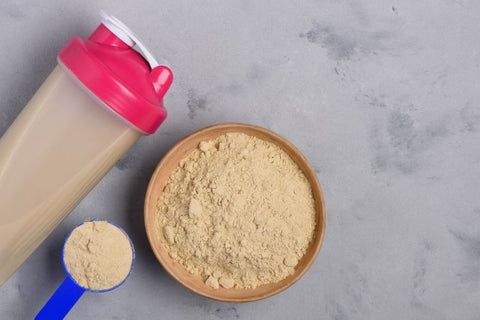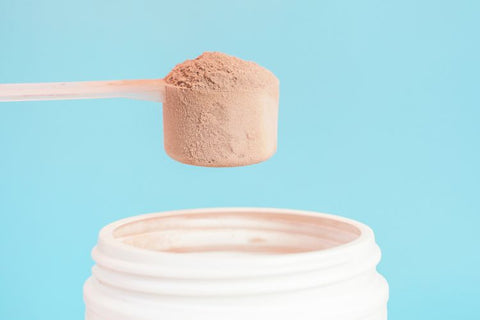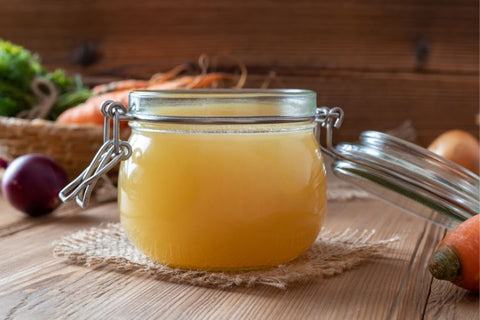Protein is a key building block for muscle tissue. After a workout, especially intense training, your muscles experience microscopic tears. Protein provides the amino acids your body needs to repair and rebuild those tears, leading to stronger muscles. This is crucial for anyone with fitness goals, whether it's building muscle mass, improving strength, or simply recovering faster to get back to the gym.
Here's where protein powder comes in. It's a convenient way to ensure you're getting enough protein to support your fitness goals. Consuming whole food sources is ideal, but protein powder offers a concentrated dose of protein in a shake or smoothie, making it easy to fit into your day, especially after a workout when you might not have a big appetite.
This guide explores the optimal ways to use protein powder to support your health goals.
Determining Your Protein Needs
Fueling your fitness journey requires the right tools, and protein is a foundational one. It's the building block of muscle, and after a workout, your muscles need protein to repair and rebuild. But how much protein is right for you? Let's explore how to calculate your daily protein requirements based on factors like age, weight, activity level, and fitness goals. Understanding these needs is crucial before reaching for protein powder, as it ensures you use this convenient supplement effectively.
Protein is essential for everyone, but the amount you need depends on several factors:
- Age: Growing children and adolescents generally need more protein per kilogram of body weight compared to adults.
- Weight: The heavier you are, the more protein your body needs for basic functions.
- Activity Level: Very active People, especially those engaged in strength training, require more protein for muscle repair and growth.
- Fitness Objectives: If your goal is building muscle mass, you'll need more protein than someone aiming for general health and fitness.
Here's a breakdown of how to estimate your daily protein needs:
-
Body Weight Method: This is a simple starting point. The Recommended Dietary Allowance (RDA) is 0.8 grams of protein per kilogram of body weight per day for adults. So, for a 70kg person, that's about 56 grams of protein.
-
Activity Level Adjustment: If you're moderately active (think brisk walking or regular gym sessions), bump up your intake by 1.2-1.6 grams per kilogram. Highly active individuals and athletes may need 1.6-2.2 grams per kilogram.
- Fitness Goal Factor: For muscle building, consider a range of 1.8-2.2 grams per kilogram.
Choosing the Right Type of Protein Powder
Protein powders offer a convenient way to boost your protein intake, but with so many options on the shelves, choosing the right one can be confusing. Let's explore the different protein types and how they align with your dietary preferences and fitness goals:
Protein Powder Types:
-
Whey Protein: This highly popular type comes from milk and is rapidly absorbed, making it ideal for post-workout recovery. Whey is a complete protein, meaning it contains all essential amino acids. However, it may not be suitable for those with lactose intolerance.
-
Casein Protein: Another milk-derived protein, casein digests slowly, providing a sustained release of amino acids over several hours. This makes it a good choice before bed to support muscle recovery throughout the night.
-
Soy Protein: A plant-based option, soy protein is a complete protein source and a good alternative for those who are lactose intolerant or vegan. Soy protein can also offer additional health benefits like improved cholesterol levels.
- Plant-Based Protein Blends: These blends combine various plant protein sources like peas, brown rice, hemp, and others. While not always complete proteins on their own, combining them strategically can provide a full spectrum of amino acids. This is a good option for vegans, vegetarians, or those with soy allergies.
- Serving Size: Labels often list protein content per scoop, but scoop sizes can vary. Focus on the protein amount in grams per serving to accurately track your intake.
- Protein Content: This is the key information. Look for powders with a high protein content per serving, ideally around 20-30 grams for a standard serving size.
- Additional Ingredients: Protein powder isn't always pure protein. Be aware of added sugars, artificial sweeteners, thickeners, and artificial flavours. These can inflate calorie intake and detract from the nutritional value.
- Serving Size: This is typically listed at the top of the label. Pay close attention to the number of scoops or grams that constitute a serving.
- Protein Content: Find the "Protein" line. This number, usually in grams (g), tells you how much protein you get per serving. Aim for powders with a high protein content relative to the serving size.
- Ingredient List: This reveals everything in the powder. Look for ingredients you recognize and prioritize those with minimal added sugars, artificial sweeteners, and fillers.
- Other Nutrients: The label might also show fat, carbohydrates, and calories per serving. Consider these about your overall dietary goals.
- Protein powder of your choice (refer to previous sections for choosing the right type)
- Liquid (water, milk, unsweetened nut milk, etc.)
- Optional: Fruits, vegetables, nut butter, yogurt, ice cubes (for a thicker consistency)
- Shaker bottle
- Spoon
- Liquids First: This is key to avoiding clumps! Add your desired amount of liquid to the shaker bottle. Water is a classic choice, but milk or unsweetened nut milk can add creaminess and extra protein. Aim for around 200-300ml of liquid depending on your preferred shake thickness.
- Protein Power: Now, add your protein powder using the provided scoop. Refer to the label for the recommended serving size.
- Optional Ingredients: If using fruits, vegetables, nut butter, or yogurt, add them after the protein powder. For bulky ingredients like frozen fruit, it might be easier to blend them with some liquid beforehand using a blender (if available).
- Secure and Shake: Screw on the lid tightly, ensuring the mixing mechanism (mesh ball or whisk) is inside. Now comes the fun part - the shake! Vigorously shake the bottle for 20-30 seconds, or until you achieve a smooth consistency.
- Enjoy! Pour your creation into a glass and enjoy your delicious and protein-packed shake.
- Berry Blast: Blend your protein powder with a handful of frozen berries (blueberries, raspberries, strawberries) for a refreshing and antioxidant-rich shake.
- Tropical Twist: Add frozen mango, pineapple, or banana for a tropical vacation in a glass. These fruits also add natural sweetness.
- Green Machine: Spinach or kale are surprisingly mild-flavoured additions to a protein shake. Pair them with a banana or mango to mask any bitterness.
- Beet It: For a vibrant pink shake with a slightly earthy taste, add cooked or roasted beets. Beets are packed with essential nutrients.
- Creamy Classic: Swap out some of the liquid in your shake for Greek yogurt. This adds protein, healthy fats, and a creamy texture.
- Probiotic Powerhouse: Choose yogurt with live and active cultures for an extra dose of gut-friendly probiotics.
- Peanut Power: A spoonful of peanut butter adds protein, healthy fats, and a delicious nutty flavour to your shake. Try other nut butter like almond or cashew for a change.
- Trail Mix Inspiration: Add a tablespoon of your favourite trail mix for a variety of textures and flavours. Just be mindful of added sugars in pre-made mixes.
- Spice it Up: Add a sprinkle of cinnamon, nutmeg, or ginger for a touch of warmth and complexity.
- Leafy Greens Power: Baby spinach or kale are surprisingly undetectable in a shake, but add a powerful dose of vitamins and minerals.
- Healthy Fats: For increased satiety and sustained energy, add a healthy fat source like avocado or chia seeds.
- Muscle Repair and Rebuild: After a workout, especially intense training, your muscles experience microscopic tears. Protein provides the amino acids your body needs to repair and rebuild those tears, leading to stronger muscles. This is crucial for anyone aiming to build muscle mass or simply recover faster to get back to the gym.
- Enhanced Protein Synthesis: Protein synthesis is the scientific term for muscle building. Consuming protein post-workout, particularly within a 1-2 hour window, stimulates muscle protein synthesis, helping your body rebuild and potentially grow muscle tissue.
- Improved Performance: Some studies indicate that consuming protein 1-2 hours before exercise can enhance performance during endurance activities or high-intensity training. The theory is that it provides a readily available amino acid pool for the body to utilize during exercise.
- Muscle Protein Synthesis Boost: Pre-workout protein may prime your body for muscle protein synthesis, potentially leading to greater gains when combined with a post-workout protein dose and proper training.
- Ditch the plain oatmeal routine. Stir your favourite protein powder into cooked oatmeal for a creamy, protein-rich breakfast. Add berries, nuts, or a drizzle of honey for extra flavour and texture.
- Layer Greek yogurt with your favourite protein powder, granola, and sliced fruits for a protein-packed parfait. This is a delicious and satisfying option for breakfast or a mid-day snack.
- Take your smoothie game to the next level! Blend your protein powder with fruits, vegetables, nut butter, and a splash of liquid to create a thick smoothie base. Pour it into a bowl and top it with your favourite toppings like granola, chia seeds, chopped nuts, or even a drizzle of dark chocolate.
- Looking for a protein-packed breakfast that's fun and fluffy? Add a scoop of protein powder to your favourite pancake batter. This will boost the protein content without sacrificing taste or texture. Top your protein pancakes with fresh fruit or a dollop of Greek yogurt.
- Sneak in some extra greens! Protein powder can mask the taste of spinach or kale in muffins, waffles, or even savoury egg bakes. This is a great way to add protein and essential nutrients to your meals.
- Protein for Satiety: Protein is known to promote feelings of fullness. A protein shake can help curb your appetite and keep you feeling satisfied until your next meal.
- Nutrient Gap Considerations: While protein powder is a good source of protein, it may lack other essential nutrients like fibre, healthy fats, vitamins, and minerals that are abundant in whole foods.
- Protein Processing: Your body uses water to break down and utilize protein for muscle repair and growth. Dehydration can hinder this process, potentially limiting the benefits you get from protein powder.
- Kidney Health: Your kidneys play a vital role in filtering out waste products from protein metabolism. Dehydration can put extra strain on your kidneys, making proper hydration essential.
- Overall Health and Performance: Adequate hydration is crucial for overall health and exercise performance. It regulates body temperature, lubricates joints, and supports various bodily functions.
- Water is King: Aim to drink plenty of water throughout the day, especially before, during, and after your workout. A good rule of thumb is to consume half your body weight in ounces of water daily.
- Factor in Protein Intake: When consuming protein powder, consider that it might require additional water for processing. Aim for at least 8-12 ounces of water per scoop of protein powder in your shake. Adjust based on your individual needs and activity level.
- Listen to Your Body: Pay attention to thirst cues and don't wait until you feel dehydrated to drink water. Aim for clear or light yellow urine, which is a good indicator of hydration status.
- Electrolytes for Extra Support: If you sweat heavily during workouts or live in a hot climate, consider adding electrolyte-enhanced water or natural sources of electrolytes (fruits like coconut water) to your routine.
- Determine your daily protein requirements based on factors like age, weight, activity level, and fitness goals.
- Select a protein powder that aligns with your dietary preferences and fitness objectives, such as whey, casein, soy, or plant-based blends.
- Pay attention to serving size, protein content per serving, and additional ingredients like sugars and artificial additives.
- Use a shaker bottle to create smooth and lump-free protein shakes by adding liquid first, then protein powder and optional ingredients like fruits or nut butter.
- Enhance the flavour and nutrition of your shakes with ingredients like berries, vegetables, Greek yogurt, or nut butter.
- Consume protein powder strategically, particularly post-workout for muscle recovery and pre-workout to support performance.
- Experiment with incorporating protein powder into meals like oatmeal, yogurt parfaits, smoothie bowls, and protein pancakes for added protein and flavour.
- Use protein shakes as a meal replacement when necessary, but prioritize whole foods for overall nutrition.
- Ensure adequate hydration to support digestion and overall health when consuming protein powder.
Read the Label
Protein powder can be a valuable tool, but navigating the labels can feel like deciphering a secret code. Don't worry, we've got you covered! Here's why label reading is crucial and how to interpret it to ensure your protein powder aligns with your nutritional needs:
Why Label Reading Matters:
Decoding the Label:
Preparing Protein Shakes
Shaker bottles are your allies in creating smooth, delicious protein shakes. But even with this handy tool, achieving a lump-free masterpiece can be a challenge. Fear not, shake enthusiasts! Here's a step-by-step guide to preparing a protein shake with a shaker bottle, along with some tips for a perfect blend:
Ingredients:
Tools:
Instructions:
Customizing Protein Shakes
Protein shakes are fantastic for delivering a protein punch, but they can be so much more! With a little creativity, you can transform your shake into a delicious and nutritious post-workout treat, or even a healthy snack throughout the day. Here's how to incorporate fruits, vegetables, yogurt, and nut butter to unlock the full flavour and nutritional potential of your protein shake:
Fruity Delights:
Veggie Power:
Yogurt Boost:
Nut Butter Magic:
The Beauty of Customization:
The beauty of protein shakes lies in their versatility. Experiment with different flavour combinations and healthy add-ins to find what works best for you. Here are some additional tips:
Timing of Protein Consumption
Protein powder is a convenient way to fuel your fitness journey, especially when it comes to muscle recovery and performance. Let's delve into the benefits of consuming protein powder strategically, both after and before your workout.
Post-Workout Protein Powerhouse:
Pre-Workout Protein Potential:
While the post-workout window is crucial, research suggests pre-workout protein may also offer benefits:
Incorporating Protein Powder into Meals
Protein powder is a champion for post-workout recovery shakes, but its potential stretches far beyond the shaker bottle. Here's how to incorporate protein powder into your everyday meals, transforming them into protein-packed powerhouses:
Oatmeal Power-Up:
Yogurt Parfait Paradise:
Smoothie Bowl Extravaganza:
Protein Pancake Power:
Hidden Veggie Boost:
Using Protein Powder as a Meal Replacement
Life can get hectic, and sometimes fitting in a balanced meal full of whole foods becomes a challenge. In these situations, protein powder can be a lifesaver, offering a convenient and portable meal replacement option. Here's how to leverage protein powder effectively for satiety and nutrition when whole food choices are limited:
Understanding Protein Powder's Role in Meal Replacement:
Protein powder is a convenient tool, but it shouldn't be your sole source of sustenance. Whenever possible, prioritize whole-food meals. If using protein powder for frequent meal replacements, consult a registered dietitian to ensure you're meeting your overall nutritional needs and creating a balanced plan.
Staying Hydrated
Protein powder is a fantastic tool for boosting your protein intake and supporting your fitness journey. However, it's crucial to remember that protein powder can be dehydrating. Let's delve into the importance of hydration when consuming protein powder and explore tips for staying adequately hydrated:
Why Hydration Matters for Protein:
Staying Hydrated with Protein Powder:
Here are some tips to ensure you're adequately hydrated when incorporating protein powder into your routine:
Conclusion
Incorporating protein powder into your fitness routine can be a powerful tool for achieving your health and fitness goals. By calculating your protein needs, selecting the right type of protein powder, and preparing customized protein shakes and meals, you can optimize muscle recovery, support performance, and enhance overall nutrition.
Remember to prioritize whole foods alongside protein powder to ensure a balanced diet and meet your body's diverse nutritional requirements. Stay hydrated and listen to your body's cues to maximize the benefits of protein supplementation.






